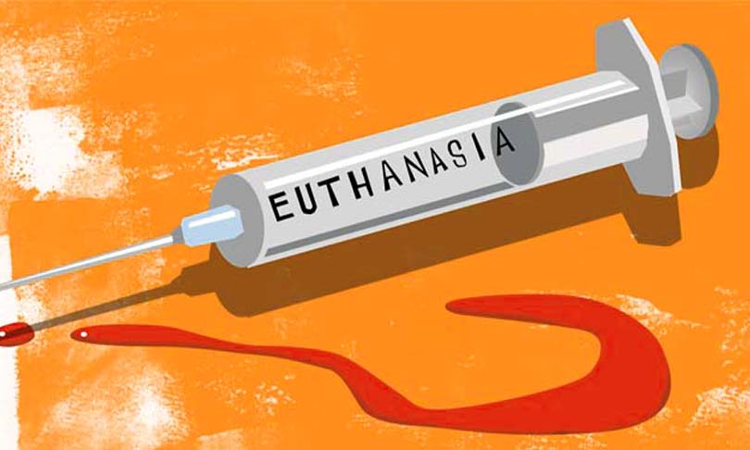TOPIC – EUTHEUTHANASIA
AUTHOR:-RISHABH DEV GAUTAM
From :-D.P. VIPRA P.G LAW COLLAGE
ASHOK NAGAR SARKANDA BILASPUR(C.G.)
To The Point
- INTRODUCTION
- ABSTRACT
- DEFINATION OF EUTHANASIA
- TYPE OF EUTHANASIA
- EUTHANASIA IS GENERALLY ILLEGAL IN INDIA
- EUTHANASIA AND ARTICLE 21
- CASE OF ARUNA SHANBAUG
- CONCLUSION
- REFERENCES
INTRODUCTION:-
Euthanasia, the deliberate act of ending a person’s life to relieve suffering, is a topic that sparks intense ethical, moral, and legal debates. As medical advancements push the boundaries of life-sustaining treatments, questions surrounding the right to die with dignity have gained prominence. This article delves into the multifaceted landscape of euthanasia, exploring its history, ethical considerations, legal status, and the ongoing discourse surrounding this complex issue.
ABSTRACT:-
This abstract provides a concise overview of the multifaceted discourse surrounding euthanasia, examining its historical roots, ethical considerations, legal implications, and societal impact. From ancient philosophical debates to modern-day legal precedents, the concept of intentionally ending a life to alleviate suffering continues to challenge societal norms. Ethical perspectives, rooted in notions of autonomy, sanctity of life, and compassion, shape the intricate dialogue. Legal frameworks, exemplified by landmark cases, navigate the delicate balance between individual rights and societal interests. This abstract encapsulates the evolving landscape of euthanasia, inviting reflection on its profound implications for human autonomy, medical ethics, and the right to a dignified death.
DEFINATION OF EUTHANASIA
Euthanasia refers to the intentional act of causing the painless death of a person who is suffering from a terminal illness, unbearable pain, or an incurable condition. The purpose of euthanasia is to alleviate the individual’s suffering by hastening their death, often with the explicit consent of the patient or their legal representatives. Euthanasia can take various forms, including active euthanasia, where a lethal substance is administered, and passive euthanasia, involving the withholding or withdrawal of life-sustaining treatments. The ethical, moral, and legal aspects of euthanasia are subjects of considerable debate and vary across different jurisdictions and cultural contexts
TYPE OF EUTHANASIA
Euthanasia can be categorized into several types based on the nature of the act and the involvement of the individuals. The main types include:
VOLUNTARY EUTHANASIA :
This occurs when a person explicitly expresses their wish to end their life, and the act is carried out in accordance with their request. It requires the patient’s informed and voluntary consent.
INVOLUNTARY EUTHANASIA :
Involuntary euthanasia occurs when a person’s life is intentionally ended without their explicit consent. This is highly controversial and is often considered unethical and illegal.
ACTIVE EUTHANASIA :
Active euthanasia involves the intentional administration of a substance (such as a lethal dose of medication) with the purpose of causing the patient’s death. This is considered a direct intervention to end life.
PASSIVE EUTHANASIA :
Passive euthanasia refers to the withholding or withdrawal of life-sustaining treatments, allowing the patient to die naturally. This could include discontinuing artificial life support or not initiating certain medical interventions.
PHYSICAL- ASSISTED SUCIDE (PAS):
In physician-assisted suicide, a medical professional provides the means or information necessary for a patient to self-administer a lethal substance, with the explicit intention of causing their own death.
INDIRECT EUTHANASIA:
Indirect euthanasia involves providing treatment or medication to alleviate pain or symptoms, which may have the unintended consequence of shortening the patient’s life.
The categorization of euthanasia is often used to discuss and analyze the ethical, legal, and moral implications associated with different forms of intentionally ending a person’s life. The acceptance and legality of these types of euthanasia vary across jurisdictions and depend on cultural, ethical, and legal perspectives.
EUTHANASIA IS GENERALLY ILLEGAL IN INDIA
Indian law, under Section 306 of the Indian Penal Code, considers abetment of suicide a criminal offense. However, the legal landscape regarding euthanasia has seen some developments.
In the landmark Aruna Shanbaug case in 2011, the Supreme Court of India recognized passive euthanasia under specific circumstances. It allowed the withdrawal of life support from patients in a persistent vegetative state if the decision was taken by a High Court after being approached by the patient’s family or friends. This decision provided a legal framework for certain forms of passive euthanasia.
Furthermore, in 2018, the Indian government passed The Mental Healthcare Act, which, among other things, allows individuals to create advance directives, outlining the medical treatments they wish to receive or refuse, including the right to refuse life-sustaining treatment.

EUTHANASIA AND ARTICLE 21 :
Euthanasia, the deliberate act of ending a person’s life to alleviate their suffering, is a contentious issue that intersects with fundamental human rights, particularly the right to life and personal liberty. In the context of legal perspectives, examining euthanasia through the lens of Article 21 of the Constitution becomes paramount, as this article safeguards these fundamental rights.
Article 21 of the Indian Constitution:
Article 21 of the Indian Constitution unequivocally states, “No person shall be deprived of his life or personal liberty except according to the procedure established by law.” This fundamental right, often regarded as the heart of the Constitution, encompasses a broader understanding of life, extending beyond mere survival to include a life with dignity.
Euthanasia and the Right to Life:
The question arises whether the right to life under Article 21 includes the right to decide the terms of one’s death, especially in cases of terminal illness or unbearable suffering. Advocates argue that depriving individuals of the choice to end their lives in such circumstances infringes upon their right to life with dignity. Opponents counter that protecting life encompasses preventing intentional acts that terminate it.
The Role of Personal Liberty:
The right to personal liberty under Article 21 is not confined to physical freedom alone but extends to the autonomy and privacy of individuals. Euthanasia, particularly in its voluntary form, is seen by proponents as an extension of personal liberty, allowing individuals control over their own bodies and destinies. However, striking a balance between autonomy and the state’s interest in protecting life is a legal tightrope.
Advanced Certificate Course in Criminal Litigation and Trial Advocacy
Legal Implications and Judicial Decisions:
The legal landscape regarding euthanasia in India has seen shifts over time. In the landmark judgment of Aruna Ramchandra Shanbaug vs. Union of India (2011), the Supreme Court of India recognized passive euthanasia under certain circumstances, emphasizing the importance of individual autonomy and dignity. This decision laid the groundwork for the concept of “living wills” and advanced directives.
International Perspectives:
Examining euthanasia in the context of Article 21 also involves considering international precedents and evolving global attitudes. Various countries, recognizing the importance of balancing individual autonomy and societal interests, have grappled with legal frameworks that address the complexities of euthanasia while upholding fundamental rights.
CASE :
One significant case that has had a profound impact on the legal understanding of euthanasia is the “Aruna Shanbaug case” in India.
Case Background:
Name: Aruna Ramchandra Shanbaug vs. Union of India (2011)
Context: Aruna Shanbaug, a nurse, had been in a persistent vegetative state for 37 years after a brutal sexual assault in 1973 left her in a coma. She was being cared for at KEM Hospital in Mumbai.
Key Legal Aspect:
Recognition of Passive Euthanasia: The Supreme Court of India, in its landmark judgment, recognized the concept of passive euthanasia in certain circumstances. It allowed for the withdrawal of life-sustaining treatment from patients in a persistent vegetative state under specific conditions.
Judicial Rationale:
The court emphasized the importance of an individual’s right to live with dignity. It acknowledged that in certain cases, continued medical intervention might prolong a life devoid of quality and dignity, and therefore, allowing the withdrawal of life support could be a compassionate choice.
Living Wills and Advance Directives:
The judgment laid the groundwork for the acceptance of living wills and advance directives in India. It acknowledged the significance of individuals expressing their preferences regarding medical treatment, including end-of-life decisions, when they are in a competent state of mind.
Impact and Subsequent Developments:
The Aruna Shanbaug case prompted discussions on the need for legal clarity regarding end-of-life decisions. Subsequently, there were calls for legislation addressing euthanasia and living wills.
Legislation and Legal Reforms:
In 2018, India passed The Mental Healthcare Act, which legalized the creation of advance directives, giving individuals the right to specify the medical treatment they wish to receive or refuse, including the right to refuse life-sustaining treatment.
Significance:
The case played a pivotal role in shaping legal discourse around euthanasia in India, particularly regarding passive euthanasia and the importance of respecting an individual’s right to die with dignity.
It highlighted the need for legal frameworks that balance the sanctity of life with the recognition of an individual’s autonomy in making end-of-life decisions.
The Aruna Shanbaug case represents a crucial legal precedent that has influenced not only the legal understanding of euthanasia in India but also contributed to broader discussions on end-of-life care, individual rights, and the ethical dimensions surrounding such decisions.
CONCLUSION :
The euthanasia debate remains a poignant and unresolved issue, balancing compassion for those suffering with concerns about the potential consequences of legalizing assisted death. As societies evolve, the need for thoughtful discourse, ethical considerations, and comprehensive legal frameworks becomes increasingly apparent. The challenge lies in finding a middle ground that respects individual autonomy while safeguarding against ethical pitfalls.
REFERENCES
1. https://en.m.wikipedia.org/wiki/Euthanasia
2. https://www.britannica.com/topic/euthanasia
2 WEEK CERTIFICATION COURSE ON SPACE LAW (APRIL, 2024)🚀
Join India’s Most Affordable Batch for Judicial Examination


